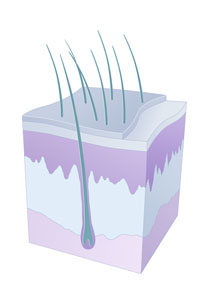Dermal (Skin)
 The skin that covers your body is called the dermal system. The skin is the barrier that protects the body from hazardous substances in the environment. Also, skin helps keep the body from losing electrolytes and fluids. Skin is the body's largest organ. It is made up of several parts: the epidermis, dermis, hypodermis, and hair, hair follicles, nails, sebaceous and sweat glands, and other skin structures.
The skin that covers your body is called the dermal system. The skin is the barrier that protects the body from hazardous substances in the environment. Also, skin helps keep the body from losing electrolytes and fluids. Skin is the body's largest organ. It is made up of several parts: the epidermis, dermis, hypodermis, and hair, hair follicles, nails, sebaceous and sweat glands, and other skin structures.
Click on a substance to go to the health effects chapter in the toxicological profile. Then, search on any target organ system to find the health effects information on that system.
Substances Listing
- 1,2-Dibromoethane
- 1,3-Butadiene
- Ammonia
- Arsenic
- Bromomethane
- Chlorinated Dibenzo-p-dioxins (CDDs)
- Chlorine Dioxide & Chlorite
- Chlorophenols
- Creosote
- Cresols
- Cyanide
- DEET (N,N-diethyl-meta-toluamide)
- Dichlorobenzenes
- Dinitrophenols
- Ethylene Oxide
- Fluorides, Hydrogen Fluoride, and Fluorine
- Formaldehyde
- Fuel Oils / Kerosene
- Fuel Oils / Kerosene
- Gasoline, Automotive
- Hydraulic Fluids
- Hydrazines
- Ionizing Radiation
- Jet Fuels JP-4 and JP-7
- JP-5, JP-8, and Jet A
- Nickel
- Nitrophenols
- Phenol
- Polybrominated Biphenyls (PBBs)
- Polychlorinated Biphenyls (PCBs)
- Polycyclic Aromatic Hydrocarbons (PAHs)
- Propylene Glycol
- Pyrethrins and Pyrethroids
- Selenium
- Stoddard Solvent
- Sulfur Mustard
- Sulfur Trioxide & Sulfuric Acid
- Tetryl
- Used Mineral-based Crankcase Oil
- White Phosphorus
Contact Us:
- Agency for Toxic Substances and Disease Registry
4770 Buford Hwy NE
Atlanta, GA 30341 - 800-CDC-INFO
(800-232-4636)
TTY: (888) 232-6348 - New Hours of Operation
8am-8pm ET/Monday-Friday
Closed Holidays
Contact CDC-INFO


